Analysis of Financial Resource Management in a Care Home Setting
VerifiedAdded on 2019/12/17
|21
|6610
|229
Report
AI Summary
This report delves into the critical aspects of financial resource management within a healthcare context, specifically focusing on care homes. It begins by outlining fundamental costing principles, including consistency, data accuracy, transparency, stakeholder engagement, casualty, and objectivity, and demonstrates the calculation of unit costs. The report then identifies key information required for effective financial resource management, emphasizing the importance of data on past and present performance, cash flow, and daily operations. It also explains the regulatory requirements associated with financial management in the sector, highlighting the role of external and internal bodies in monitoring financial aspects. The report further evaluates the contribution of computer software in management, comparing different options based on organizational size, accounting complexity, features, and price. The second part of the report discusses various income sources for care homes, including public, private, and voluntary organizations, and analyzes factors affecting finance availability, such as government funding and fiscal policies. It reviews relevant budgets and explains expenditure decision-making processes. The third task includes preparing a cash budget, addressing fraud suspicion, and evaluating budget monitoring and control methods. Finally, the report identifies the information required for decision-making, analyzes the relationship between service levels, costs, and expenditure, evaluates the impact of financial considerations on individuals, and suggests improvements through better financial systems and processes.
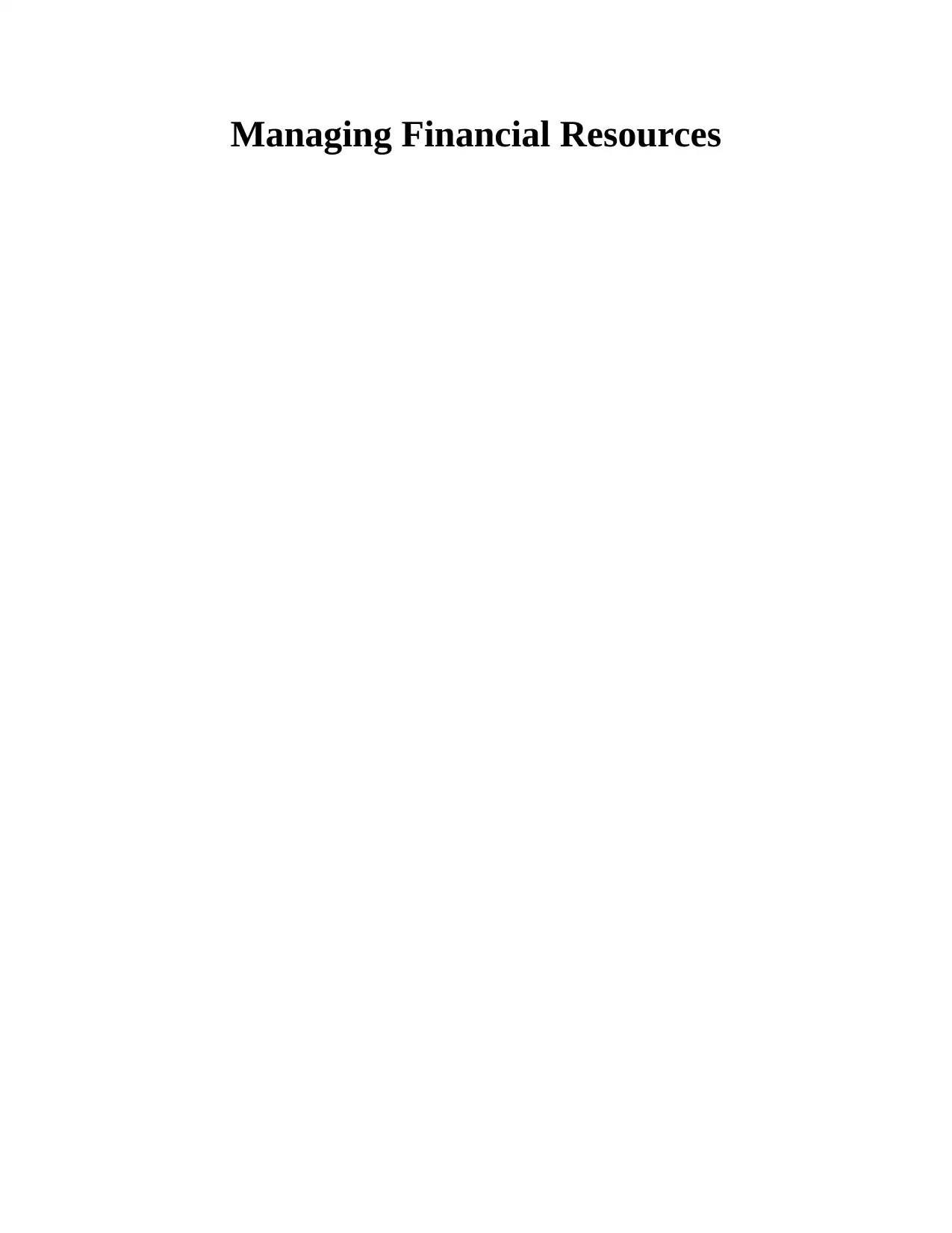
Managing Financial Resources
Paraphrase This Document
Need a fresh take? Get an instant paraphrase of this document with our AI Paraphraser
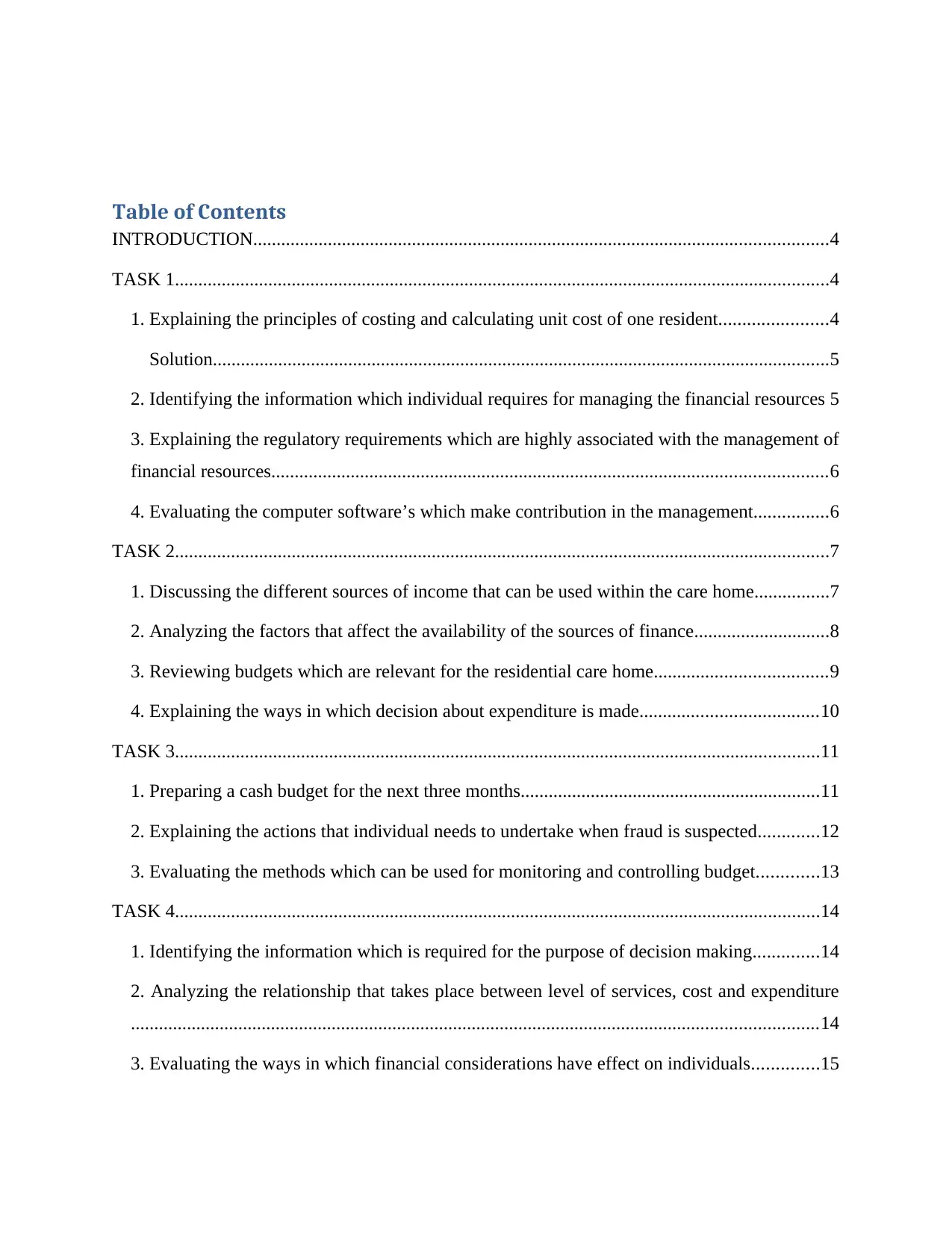
Table of Contents
INTRODUCTION...........................................................................................................................4
TASK 1............................................................................................................................................4
1. Explaining the principles of costing and calculating unit cost of one resident.......................4
Solution....................................................................................................................................5
2. Identifying the information which individual requires for managing the financial resources 5
3. Explaining the regulatory requirements which are highly associated with the management of
financial resources.......................................................................................................................6
4. Evaluating the computer software’s which make contribution in the management................6
TASK 2............................................................................................................................................7
1. Discussing the different sources of income that can be used within the care home................7
2. Analyzing the factors that affect the availability of the sources of finance.............................8
3. Reviewing budgets which are relevant for the residential care home.....................................9
4. Explaining the ways in which decision about expenditure is made......................................10
TASK 3..........................................................................................................................................11
1. Preparing a cash budget for the next three months................................................................11
2. Explaining the actions that individual needs to undertake when fraud is suspected.............12
3. Evaluating the methods which can be used for monitoring and controlling budget.............13
TASK 4..........................................................................................................................................14
1. Identifying the information which is required for the purpose of decision making..............14
2. Analyzing the relationship that takes place between level of services, cost and expenditure
...................................................................................................................................................14
3. Evaluating the ways in which financial considerations have effect on individuals..............15
INTRODUCTION...........................................................................................................................4
TASK 1............................................................................................................................................4
1. Explaining the principles of costing and calculating unit cost of one resident.......................4
Solution....................................................................................................................................5
2. Identifying the information which individual requires for managing the financial resources 5
3. Explaining the regulatory requirements which are highly associated with the management of
financial resources.......................................................................................................................6
4. Evaluating the computer software’s which make contribution in the management................6
TASK 2............................................................................................................................................7
1. Discussing the different sources of income that can be used within the care home................7
2. Analyzing the factors that affect the availability of the sources of finance.............................8
3. Reviewing budgets which are relevant for the residential care home.....................................9
4. Explaining the ways in which decision about expenditure is made......................................10
TASK 3..........................................................................................................................................11
1. Preparing a cash budget for the next three months................................................................11
2. Explaining the actions that individual needs to undertake when fraud is suspected.............12
3. Evaluating the methods which can be used for monitoring and controlling budget.............13
TASK 4..........................................................................................................................................14
1. Identifying the information which is required for the purpose of decision making..............14
2. Analyzing the relationship that takes place between level of services, cost and expenditure
...................................................................................................................................................14
3. Evaluating the ways in which financial considerations have effect on individuals..............15

4. Suggesting ways in which services can be improved through better financial system and
processes....................................................................................................................................15
CONCLUSION..............................................................................................................................16
REFERENCES..............................................................................................................................17
processes....................................................................................................................................15
CONCLUSION..............................................................................................................................16
REFERENCES..............................................................................................................................17
⊘ This is a preview!⊘
Do you want full access?
Subscribe today to unlock all pages.

Trusted by 1+ million students worldwide
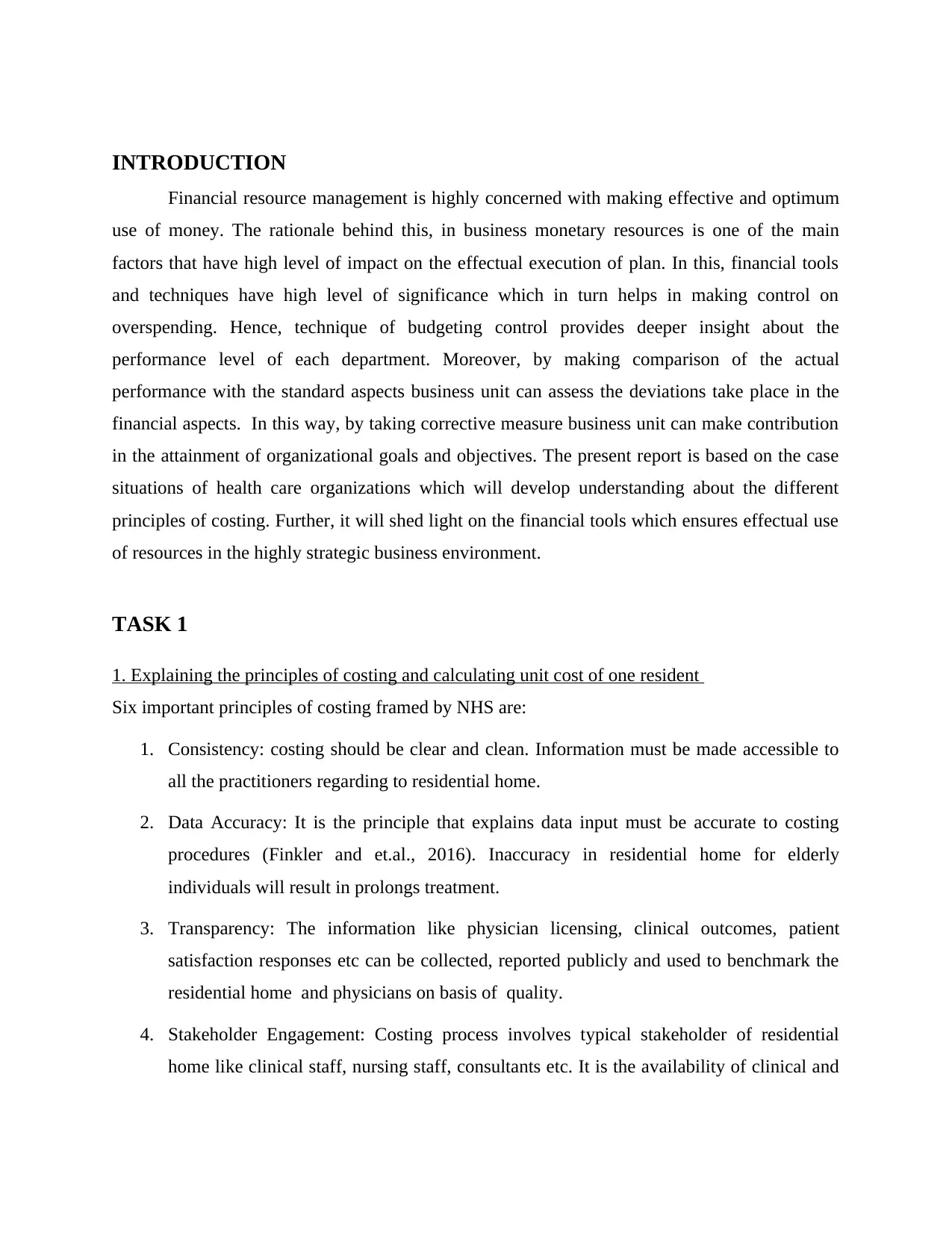
INTRODUCTION
Financial resource management is highly concerned with making effective and optimum
use of money. The rationale behind this, in business monetary resources is one of the main
factors that have high level of impact on the effectual execution of plan. In this, financial tools
and techniques have high level of significance which in turn helps in making control on
overspending. Hence, technique of budgeting control provides deeper insight about the
performance level of each department. Moreover, by making comparison of the actual
performance with the standard aspects business unit can assess the deviations take place in the
financial aspects. In this way, by taking corrective measure business unit can make contribution
in the attainment of organizational goals and objectives. The present report is based on the case
situations of health care organizations which will develop understanding about the different
principles of costing. Further, it will shed light on the financial tools which ensures effectual use
of resources in the highly strategic business environment.
TASK 1
1. Explaining the principles of costing and calculating unit cost of one resident
Six important principles of costing framed by NHS are:
1. Consistency: costing should be clear and clean. Information must be made accessible to
all the practitioners regarding to residential home.
2. Data Accuracy: It is the principle that explains data input must be accurate to costing
procedures (Finkler and et.al., 2016). Inaccuracy in residential home for elderly
individuals will result in prolongs treatment.
3. Transparency: The information like physician licensing, clinical outcomes, patient
satisfaction responses etc can be collected, reported publicly and used to benchmark the
residential home and physicians on basis of quality.
4. Stakeholder Engagement: Costing process involves typical stakeholder of residential
home like clinical staff, nursing staff, consultants etc. It is the availability of clinical and
Financial resource management is highly concerned with making effective and optimum
use of money. The rationale behind this, in business monetary resources is one of the main
factors that have high level of impact on the effectual execution of plan. In this, financial tools
and techniques have high level of significance which in turn helps in making control on
overspending. Hence, technique of budgeting control provides deeper insight about the
performance level of each department. Moreover, by making comparison of the actual
performance with the standard aspects business unit can assess the deviations take place in the
financial aspects. In this way, by taking corrective measure business unit can make contribution
in the attainment of organizational goals and objectives. The present report is based on the case
situations of health care organizations which will develop understanding about the different
principles of costing. Further, it will shed light on the financial tools which ensures effectual use
of resources in the highly strategic business environment.
TASK 1
1. Explaining the principles of costing and calculating unit cost of one resident
Six important principles of costing framed by NHS are:
1. Consistency: costing should be clear and clean. Information must be made accessible to
all the practitioners regarding to residential home.
2. Data Accuracy: It is the principle that explains data input must be accurate to costing
procedures (Finkler and et.al., 2016). Inaccuracy in residential home for elderly
individuals will result in prolongs treatment.
3. Transparency: The information like physician licensing, clinical outcomes, patient
satisfaction responses etc can be collected, reported publicly and used to benchmark the
residential home and physicians on basis of quality.
4. Stakeholder Engagement: Costing process involves typical stakeholder of residential
home like clinical staff, nursing staff, consultants etc. It is the availability of clinical and
Paraphrase This Document
Need a fresh take? Get an instant paraphrase of this document with our AI Paraphraser
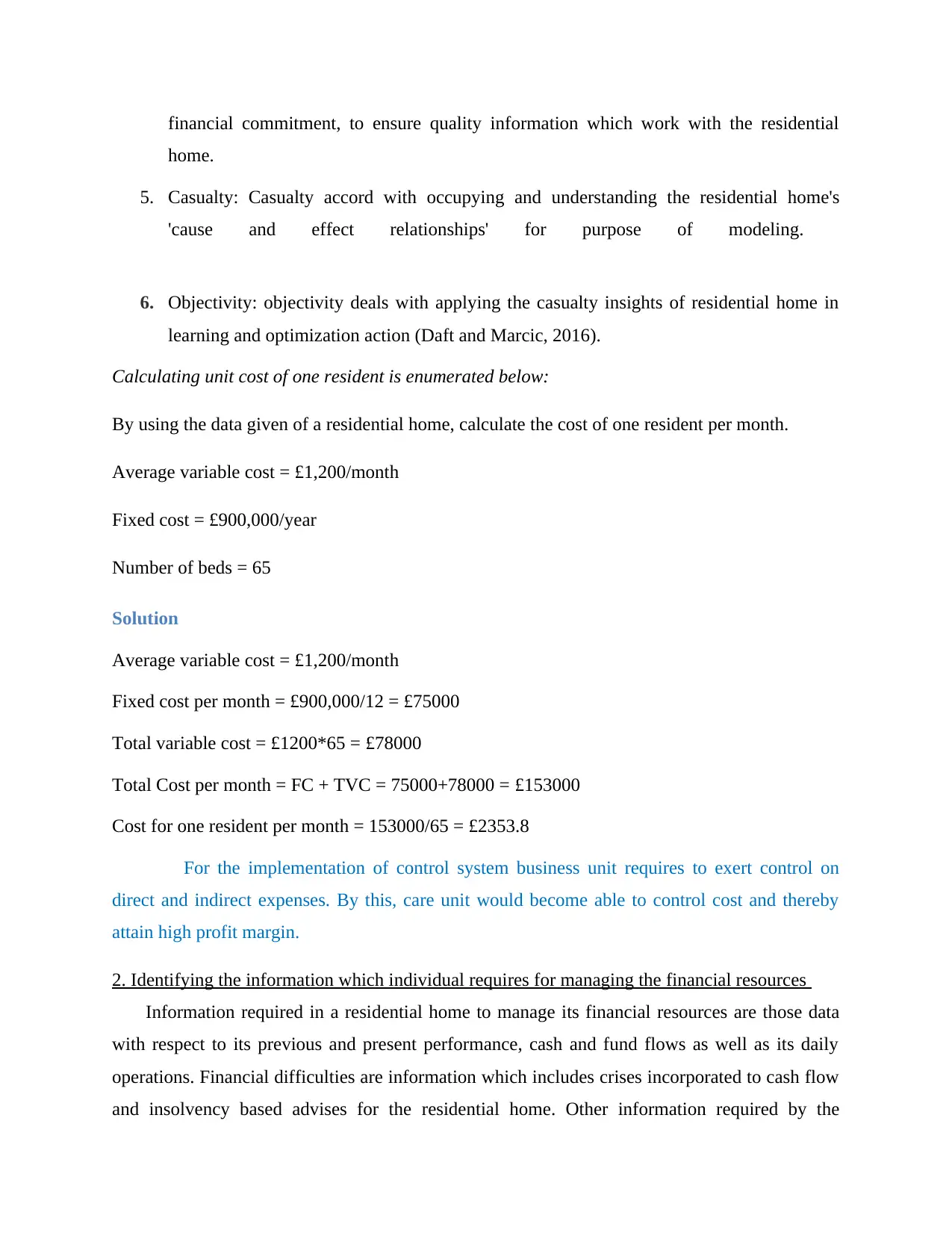
financial commitment, to ensure quality information which work with the residential
home.
5. Casualty: Casualty accord with occupying and understanding the residential home's
'cause and effect relationships' for purpose of modeling.
6. Objectivity: objectivity deals with applying the casualty insights of residential home in
learning and optimization action (Daft and Marcic, 2016).
Calculating unit cost of one resident is enumerated below:
By using the data given of a residential home, calculate the cost of one resident per month.
Average variable cost = £1,200/month
Fixed cost = £900,000/year
Number of beds = 65
Solution
Average variable cost = £1,200/month
Fixed cost per month = £900,000/12 = £75000
Total variable cost = £1200*65 = £78000
Total Cost per month = FC + TVC = 75000+78000 = £153000
Cost for one resident per month = 153000/65 = £2353.8
For the implementation of control system business unit requires to exert control on
direct and indirect expenses. By this, care unit would become able to control cost and thereby
attain high profit margin.
2. Identifying the information which individual requires for managing the financial resources
Information required in a residential home to manage its financial resources are those data
with respect to its previous and present performance, cash and fund flows as well as its daily
operations. Financial difficulties are information which includes crises incorporated to cash flow
and insolvency based advises for the residential home. Other information required by the
home.
5. Casualty: Casualty accord with occupying and understanding the residential home's
'cause and effect relationships' for purpose of modeling.
6. Objectivity: objectivity deals with applying the casualty insights of residential home in
learning and optimization action (Daft and Marcic, 2016).
Calculating unit cost of one resident is enumerated below:
By using the data given of a residential home, calculate the cost of one resident per month.
Average variable cost = £1,200/month
Fixed cost = £900,000/year
Number of beds = 65
Solution
Average variable cost = £1,200/month
Fixed cost per month = £900,000/12 = £75000
Total variable cost = £1200*65 = £78000
Total Cost per month = FC + TVC = 75000+78000 = £153000
Cost for one resident per month = 153000/65 = £2353.8
For the implementation of control system business unit requires to exert control on
direct and indirect expenses. By this, care unit would become able to control cost and thereby
attain high profit margin.
2. Identifying the information which individual requires for managing the financial resources
Information required in a residential home to manage its financial resources are those data
with respect to its previous and present performance, cash and fund flows as well as its daily
operations. Financial difficulties are information which includes crises incorporated to cash flow
and insolvency based advises for the residential home. Other information required by the
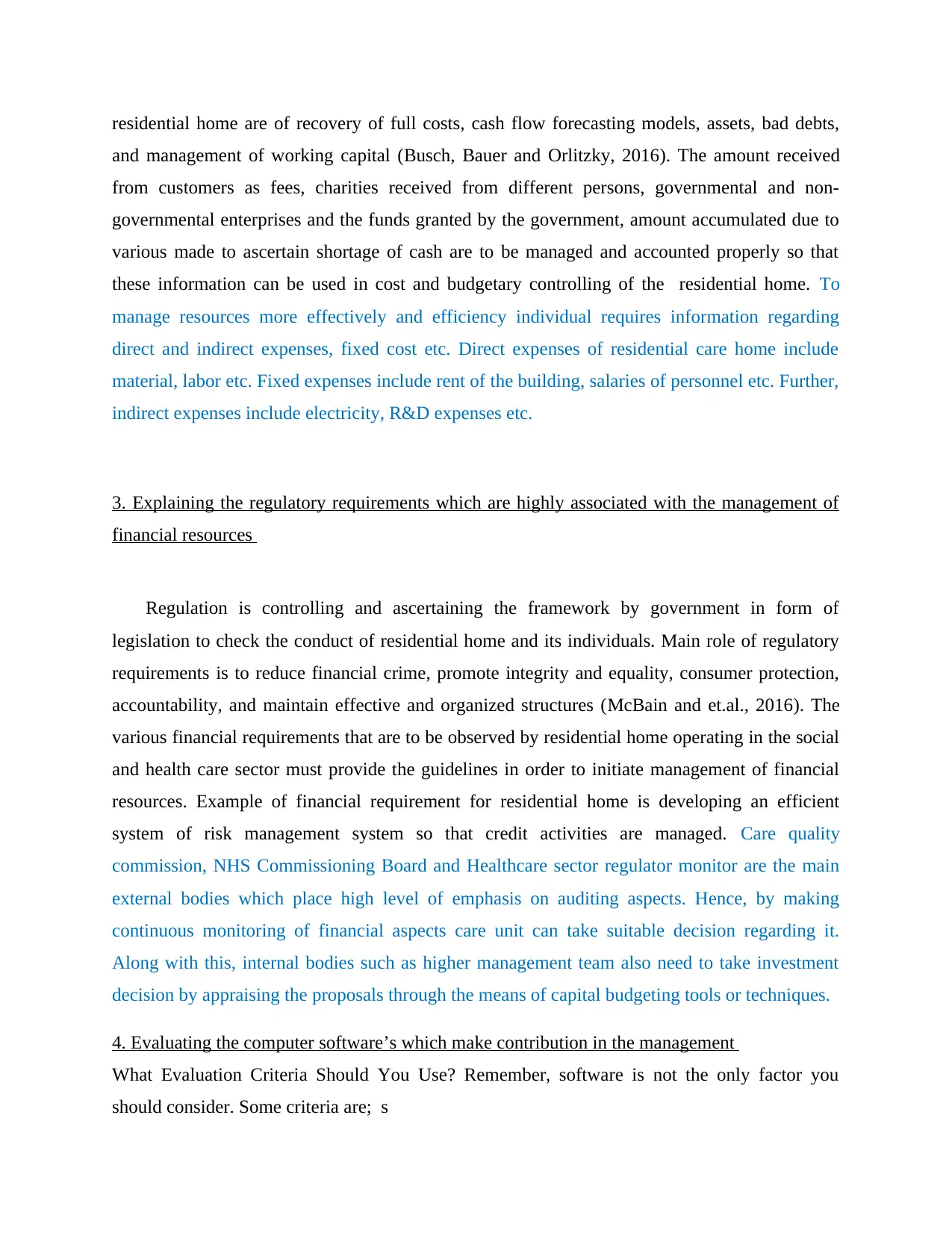
residential home are of recovery of full costs, cash flow forecasting models, assets, bad debts,
and management of working capital (Busch, Bauer and Orlitzky, 2016). The amount received
from customers as fees, charities received from different persons, governmental and non-
governmental enterprises and the funds granted by the government, amount accumulated due to
various made to ascertain shortage of cash are to be managed and accounted properly so that
these information can be used in cost and budgetary controlling of the residential home. To
manage resources more effectively and efficiency individual requires information regarding
direct and indirect expenses, fixed cost etc. Direct expenses of residential care home include
material, labor etc. Fixed expenses include rent of the building, salaries of personnel etc. Further,
indirect expenses include electricity, R&D expenses etc.
3. Explaining the regulatory requirements which are highly associated with the management of
financial resources
Regulation is controlling and ascertaining the framework by government in form of
legislation to check the conduct of residential home and its individuals. Main role of regulatory
requirements is to reduce financial crime, promote integrity and equality, consumer protection,
accountability, and maintain effective and organized structures (McBain and et.al., 2016). The
various financial requirements that are to be observed by residential home operating in the social
and health care sector must provide the guidelines in order to initiate management of financial
resources. Example of financial requirement for residential home is developing an efficient
system of risk management system so that credit activities are managed. Care quality
commission, NHS Commissioning Board and Healthcare sector regulator monitor are the main
external bodies which place high level of emphasis on auditing aspects. Hence, by making
continuous monitoring of financial aspects care unit can take suitable decision regarding it.
Along with this, internal bodies such as higher management team also need to take investment
decision by appraising the proposals through the means of capital budgeting tools or techniques.
4. Evaluating the computer software’s which make contribution in the management
What Evaluation Criteria Should You Use? Remember, software is not the only factor you
should consider. Some criteria are; s
and management of working capital (Busch, Bauer and Orlitzky, 2016). The amount received
from customers as fees, charities received from different persons, governmental and non-
governmental enterprises and the funds granted by the government, amount accumulated due to
various made to ascertain shortage of cash are to be managed and accounted properly so that
these information can be used in cost and budgetary controlling of the residential home. To
manage resources more effectively and efficiency individual requires information regarding
direct and indirect expenses, fixed cost etc. Direct expenses of residential care home include
material, labor etc. Fixed expenses include rent of the building, salaries of personnel etc. Further,
indirect expenses include electricity, R&D expenses etc.
3. Explaining the regulatory requirements which are highly associated with the management of
financial resources
Regulation is controlling and ascertaining the framework by government in form of
legislation to check the conduct of residential home and its individuals. Main role of regulatory
requirements is to reduce financial crime, promote integrity and equality, consumer protection,
accountability, and maintain effective and organized structures (McBain and et.al., 2016). The
various financial requirements that are to be observed by residential home operating in the social
and health care sector must provide the guidelines in order to initiate management of financial
resources. Example of financial requirement for residential home is developing an efficient
system of risk management system so that credit activities are managed. Care quality
commission, NHS Commissioning Board and Healthcare sector regulator monitor are the main
external bodies which place high level of emphasis on auditing aspects. Hence, by making
continuous monitoring of financial aspects care unit can take suitable decision regarding it.
Along with this, internal bodies such as higher management team also need to take investment
decision by appraising the proposals through the means of capital budgeting tools or techniques.
4. Evaluating the computer software’s which make contribution in the management
What Evaluation Criteria Should You Use? Remember, software is not the only factor you
should consider. Some criteria are; s
⊘ This is a preview!⊘
Do you want full access?
Subscribe today to unlock all pages.

Trusted by 1+ million students worldwide
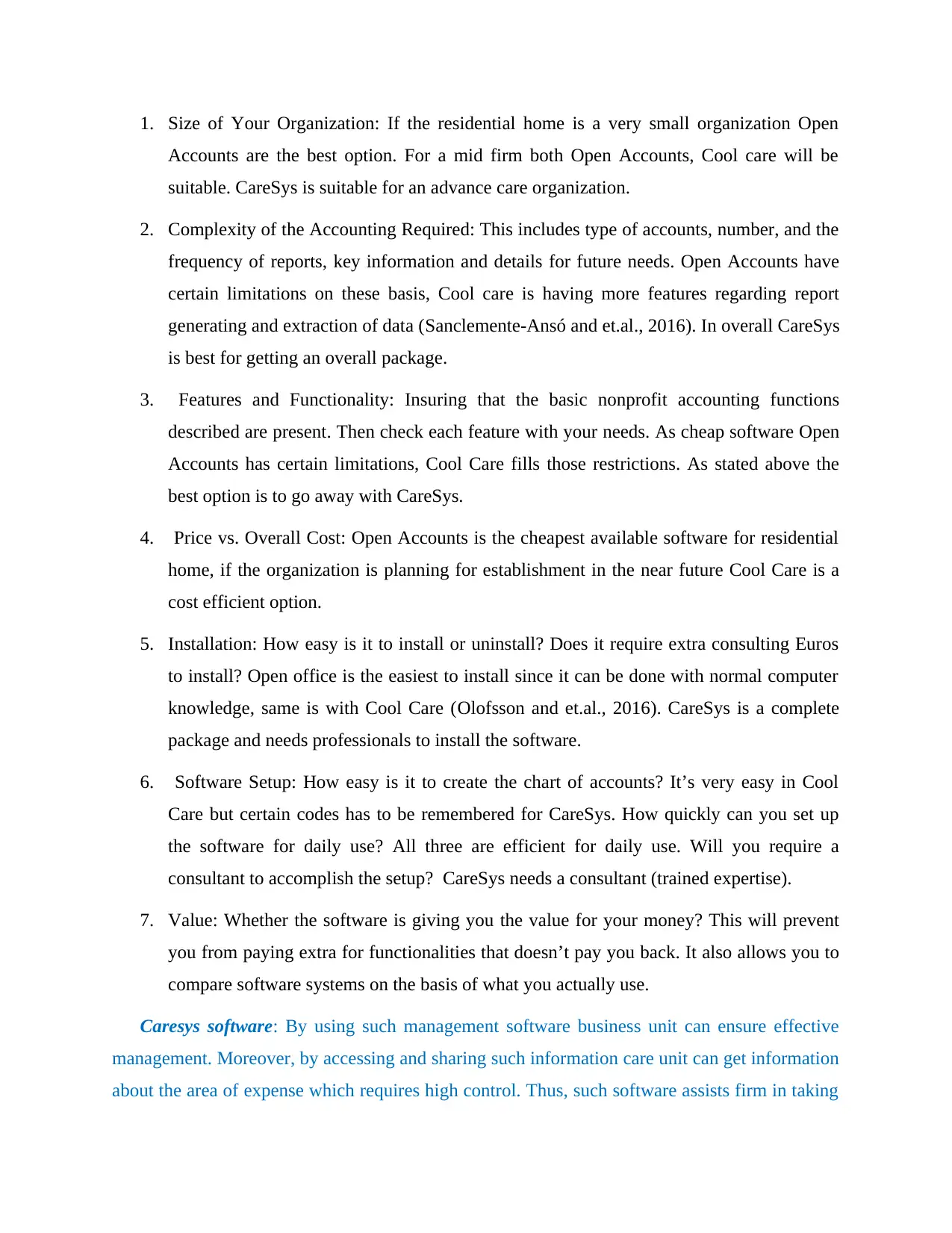
1. Size of Your Organization: If the residential home is a very small organization Open
Accounts are the best option. For a mid firm both Open Accounts, Cool care will be
suitable. CareSys is suitable for an advance care organization.
2. Complexity of the Accounting Required: This includes type of accounts, number, and the
frequency of reports, key information and details for future needs. Open Accounts have
certain limitations on these basis, Cool care is having more features regarding report
generating and extraction of data (Sanclemente-Ansó and et.al., 2016). In overall CareSys
is best for getting an overall package.
3. Features and Functionality: Insuring that the basic nonprofit accounting functions
described are present. Then check each feature with your needs. As cheap software Open
Accounts has certain limitations, Cool Care fills those restrictions. As stated above the
best option is to go away with CareSys.
4. Price vs. Overall Cost: Open Accounts is the cheapest available software for residential
home, if the organization is planning for establishment in the near future Cool Care is a
cost efficient option.
5. Installation: How easy is it to install or uninstall? Does it require extra consulting Euros
to install? Open office is the easiest to install since it can be done with normal computer
knowledge, same is with Cool Care (Olofsson and et.al., 2016). CareSys is a complete
package and needs professionals to install the software.
6. Software Setup: How easy is it to create the chart of accounts? It’s very easy in Cool
Care but certain codes has to be remembered for CareSys. How quickly can you set up
the software for daily use? All three are efficient for daily use. Will you require a
consultant to accomplish the setup? CareSys needs a consultant (trained expertise).
7. Value: Whether the software is giving you the value for your money? This will prevent
you from paying extra for functionalities that doesn’t pay you back. It also allows you to
compare software systems on the basis of what you actually use.
Caresys software: By using such management software business unit can ensure effective
management. Moreover, by accessing and sharing such information care unit can get information
about the area of expense which requires high control. Thus, such software assists firm in taking
Accounts are the best option. For a mid firm both Open Accounts, Cool care will be
suitable. CareSys is suitable for an advance care organization.
2. Complexity of the Accounting Required: This includes type of accounts, number, and the
frequency of reports, key information and details for future needs. Open Accounts have
certain limitations on these basis, Cool care is having more features regarding report
generating and extraction of data (Sanclemente-Ansó and et.al., 2016). In overall CareSys
is best for getting an overall package.
3. Features and Functionality: Insuring that the basic nonprofit accounting functions
described are present. Then check each feature with your needs. As cheap software Open
Accounts has certain limitations, Cool Care fills those restrictions. As stated above the
best option is to go away with CareSys.
4. Price vs. Overall Cost: Open Accounts is the cheapest available software for residential
home, if the organization is planning for establishment in the near future Cool Care is a
cost efficient option.
5. Installation: How easy is it to install or uninstall? Does it require extra consulting Euros
to install? Open office is the easiest to install since it can be done with normal computer
knowledge, same is with Cool Care (Olofsson and et.al., 2016). CareSys is a complete
package and needs professionals to install the software.
6. Software Setup: How easy is it to create the chart of accounts? It’s very easy in Cool
Care but certain codes has to be remembered for CareSys. How quickly can you set up
the software for daily use? All three are efficient for daily use. Will you require a
consultant to accomplish the setup? CareSys needs a consultant (trained expertise).
7. Value: Whether the software is giving you the value for your money? This will prevent
you from paying extra for functionalities that doesn’t pay you back. It also allows you to
compare software systems on the basis of what you actually use.
Caresys software: By using such management software business unit can ensure effective
management. Moreover, by accessing and sharing such information care unit can get information
about the area of expense which requires high control. Thus, such software assists firm in taking
Paraphrase This Document
Need a fresh take? Get an instant paraphrase of this document with our AI Paraphraser
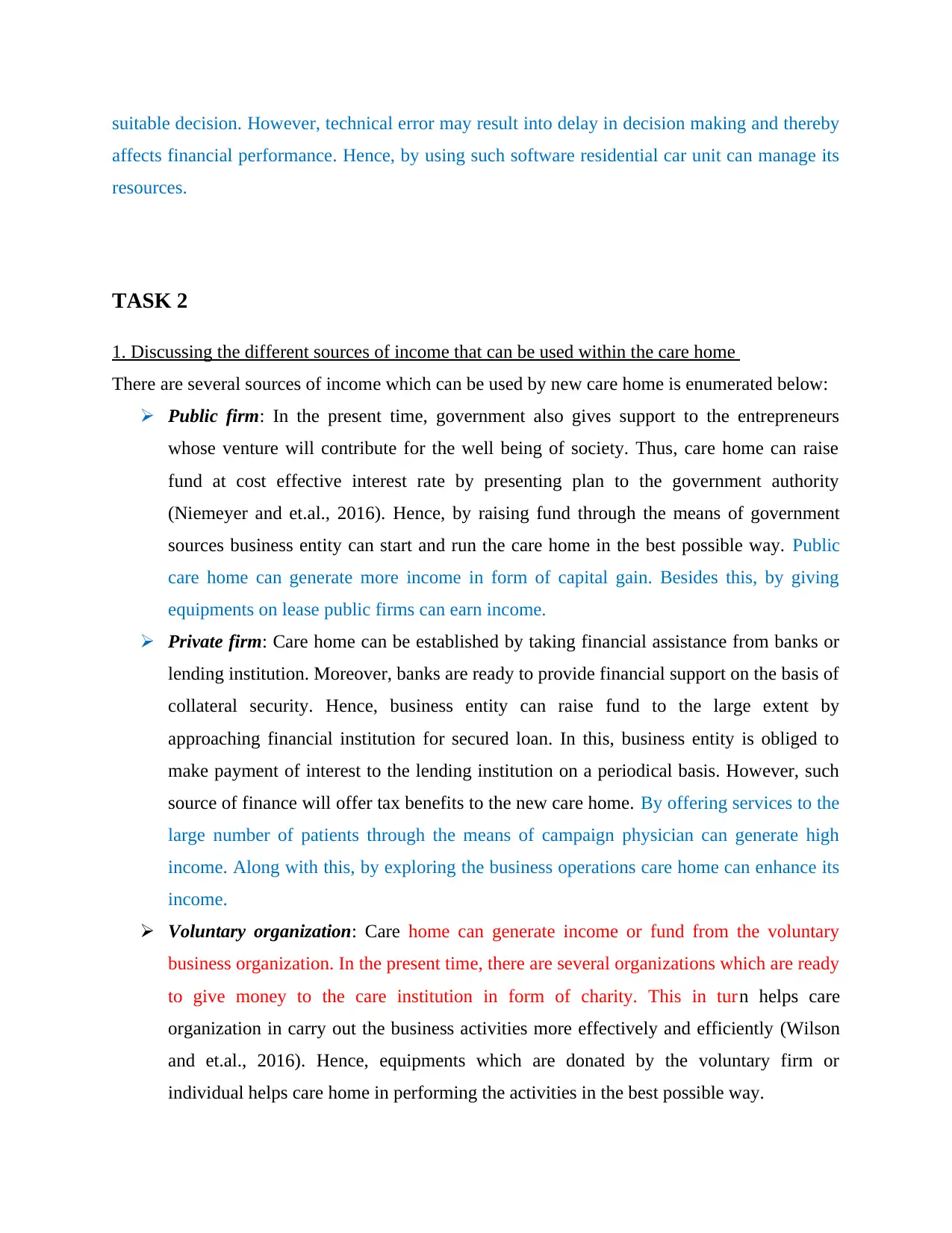
suitable decision. However, technical error may result into delay in decision making and thereby
affects financial performance. Hence, by using such software residential car unit can manage its
resources.
TASK 2
1. Discussing the different sources of income that can be used within the care home
There are several sources of income which can be used by new care home is enumerated below:
Public firm: In the present time, government also gives support to the entrepreneurs
whose venture will contribute for the well being of society. Thus, care home can raise
fund at cost effective interest rate by presenting plan to the government authority
(Niemeyer and et.al., 2016). Hence, by raising fund through the means of government
sources business entity can start and run the care home in the best possible way. Public
care home can generate more income in form of capital gain. Besides this, by giving
equipments on lease public firms can earn income.
Private firm: Care home can be established by taking financial assistance from banks or
lending institution. Moreover, banks are ready to provide financial support on the basis of
collateral security. Hence, business entity can raise fund to the large extent by
approaching financial institution for secured loan. In this, business entity is obliged to
make payment of interest to the lending institution on a periodical basis. However, such
source of finance will offer tax benefits to the new care home. By offering services to the
large number of patients through the means of campaign physician can generate high
income. Along with this, by exploring the business operations care home can enhance its
income.
Voluntary organization: Care home can generate income or fund from the voluntary
business organization. In the present time, there are several organizations which are ready
to give money to the care institution in form of charity. This in turn helps care
organization in carry out the business activities more effectively and efficiently (Wilson
and et.al., 2016). Hence, equipments which are donated by the voluntary firm or
individual helps care home in performing the activities in the best possible way.
affects financial performance. Hence, by using such software residential car unit can manage its
resources.
TASK 2
1. Discussing the different sources of income that can be used within the care home
There are several sources of income which can be used by new care home is enumerated below:
Public firm: In the present time, government also gives support to the entrepreneurs
whose venture will contribute for the well being of society. Thus, care home can raise
fund at cost effective interest rate by presenting plan to the government authority
(Niemeyer and et.al., 2016). Hence, by raising fund through the means of government
sources business entity can start and run the care home in the best possible way. Public
care home can generate more income in form of capital gain. Besides this, by giving
equipments on lease public firms can earn income.
Private firm: Care home can be established by taking financial assistance from banks or
lending institution. Moreover, banks are ready to provide financial support on the basis of
collateral security. Hence, business entity can raise fund to the large extent by
approaching financial institution for secured loan. In this, business entity is obliged to
make payment of interest to the lending institution on a periodical basis. However, such
source of finance will offer tax benefits to the new care home. By offering services to the
large number of patients through the means of campaign physician can generate high
income. Along with this, by exploring the business operations care home can enhance its
income.
Voluntary organization: Care home can generate income or fund from the voluntary
business organization. In the present time, there are several organizations which are ready
to give money to the care institution in form of charity. This in turn helps care
organization in carry out the business activities more effectively and efficiently (Wilson
and et.al., 2016). Hence, equipments which are donated by the voluntary firm or
individual helps care home in performing the activities in the best possible way.
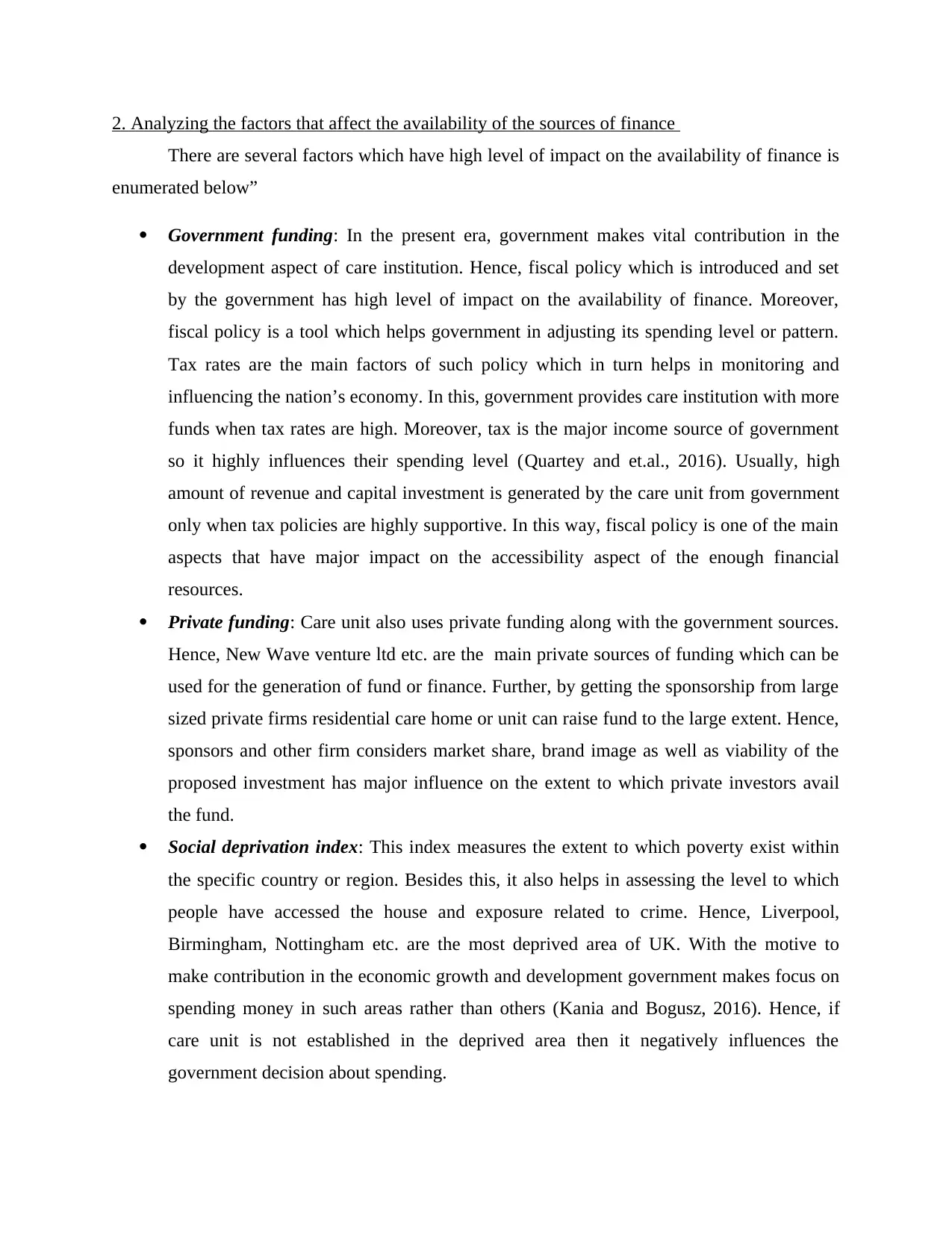
2. Analyzing the factors that affect the availability of the sources of finance
There are several factors which have high level of impact on the availability of finance is
enumerated below”
Government funding: In the present era, government makes vital contribution in the
development aspect of care institution. Hence, fiscal policy which is introduced and set
by the government has high level of impact on the availability of finance. Moreover,
fiscal policy is a tool which helps government in adjusting its spending level or pattern.
Tax rates are the main factors of such policy which in turn helps in monitoring and
influencing the nation’s economy. In this, government provides care institution with more
funds when tax rates are high. Moreover, tax is the major income source of government
so it highly influences their spending level (Quartey and et.al., 2016). Usually, high
amount of revenue and capital investment is generated by the care unit from government
only when tax policies are highly supportive. In this way, fiscal policy is one of the main
aspects that have major impact on the accessibility aspect of the enough financial
resources.
Private funding: Care unit also uses private funding along with the government sources.
Hence, New Wave venture ltd etc. are the main private sources of funding which can be
used for the generation of fund or finance. Further, by getting the sponsorship from large
sized private firms residential care home or unit can raise fund to the large extent. Hence,
sponsors and other firm considers market share, brand image as well as viability of the
proposed investment has major influence on the extent to which private investors avail
the fund.
Social deprivation index: This index measures the extent to which poverty exist within
the specific country or region. Besides this, it also helps in assessing the level to which
people have accessed the house and exposure related to crime. Hence, Liverpool,
Birmingham, Nottingham etc. are the most deprived area of UK. With the motive to
make contribution in the economic growth and development government makes focus on
spending money in such areas rather than others (Kania and Bogusz, 2016). Hence, if
care unit is not established in the deprived area then it negatively influences the
government decision about spending.
There are several factors which have high level of impact on the availability of finance is
enumerated below”
Government funding: In the present era, government makes vital contribution in the
development aspect of care institution. Hence, fiscal policy which is introduced and set
by the government has high level of impact on the availability of finance. Moreover,
fiscal policy is a tool which helps government in adjusting its spending level or pattern.
Tax rates are the main factors of such policy which in turn helps in monitoring and
influencing the nation’s economy. In this, government provides care institution with more
funds when tax rates are high. Moreover, tax is the major income source of government
so it highly influences their spending level (Quartey and et.al., 2016). Usually, high
amount of revenue and capital investment is generated by the care unit from government
only when tax policies are highly supportive. In this way, fiscal policy is one of the main
aspects that have major impact on the accessibility aspect of the enough financial
resources.
Private funding: Care unit also uses private funding along with the government sources.
Hence, New Wave venture ltd etc. are the main private sources of funding which can be
used for the generation of fund or finance. Further, by getting the sponsorship from large
sized private firms residential care home or unit can raise fund to the large extent. Hence,
sponsors and other firm considers market share, brand image as well as viability of the
proposed investment has major influence on the extent to which private investors avail
the fund.
Social deprivation index: This index measures the extent to which poverty exist within
the specific country or region. Besides this, it also helps in assessing the level to which
people have accessed the house and exposure related to crime. Hence, Liverpool,
Birmingham, Nottingham etc. are the most deprived area of UK. With the motive to
make contribution in the economic growth and development government makes focus on
spending money in such areas rather than others (Kania and Bogusz, 2016). Hence, if
care unit is not established in the deprived area then it negatively influences the
government decision about spending.
⊘ This is a preview!⊘
Do you want full access?
Subscribe today to unlock all pages.

Trusted by 1+ million students worldwide

Priority of the project: Government invests fund in the projects by setting the priority
level. For instance: Investing fund in R&D, infrastructural development is one of the
main projects which are undertaken by the government (Sources of finance, 2017). In
this, government prefers to provide care unit with more fund only when they have enough
of financial resources.
Hence, owner of the care unit needs to consider all such aspects while framing the business
policies and framework. Moreover, in the absence of having enough fund care unit would not
become able to execute the business plan.
3. Reviewing budgets which are relevant for the residential care home
Cost centre’s: It is one of the most effectual means through which residential care home can
make control on the cost and profit level. Moreover, cost centre’s are assigned with the
responsibility to make their best efforts for attaining the budgeted profit amount By this, ability
and performance of the employees can be measured more effectively and efficiently. Moreover,
cost is one of the main factors which have high level of influence on customer decision making
and profit level. In this way, such centre indirectly makes contribution in the profit margin (What
is cost centre, 2017). Thus, personnel work in such centre has accountability to manage or
maintain the level of R&D in accordance with budget. Hence, by assessing the deviations
business unit can find out the deviations that take place in performance.
`Project management budgets: Care home can also review the budget by taking into
consideration the project management. Moreover, project budget clearly shows the manner in
which money will be used by each department along with the time frame. Hence, by making
comparison of the actual performance in against to such project plan owner of the care home can
assess the areas of deviation (Niemeyer and et.al., 2016). This in turn enables them to undertake
corrective measure within the suitable time frame and thereby makes contribution in the
attainment of organizational goals and objectives. It is one of main benefits of such system.
However, if business unit fails to develop suitable budget then it may result into high deviations
which in turn negatively affects employee motivation.
Outsourcing: By taking services from external providers care home can develop suitable
framework. Moreover, experts have better idea about the fund which residential care unit
level. For instance: Investing fund in R&D, infrastructural development is one of the
main projects which are undertaken by the government (Sources of finance, 2017). In
this, government prefers to provide care unit with more fund only when they have enough
of financial resources.
Hence, owner of the care unit needs to consider all such aspects while framing the business
policies and framework. Moreover, in the absence of having enough fund care unit would not
become able to execute the business plan.
3. Reviewing budgets which are relevant for the residential care home
Cost centre’s: It is one of the most effectual means through which residential care home can
make control on the cost and profit level. Moreover, cost centre’s are assigned with the
responsibility to make their best efforts for attaining the budgeted profit amount By this, ability
and performance of the employees can be measured more effectively and efficiently. Moreover,
cost is one of the main factors which have high level of influence on customer decision making
and profit level. In this way, such centre indirectly makes contribution in the profit margin (What
is cost centre, 2017). Thus, personnel work in such centre has accountability to manage or
maintain the level of R&D in accordance with budget. Hence, by assessing the deviations
business unit can find out the deviations that take place in performance.
`Project management budgets: Care home can also review the budget by taking into
consideration the project management. Moreover, project budget clearly shows the manner in
which money will be used by each department along with the time frame. Hence, by making
comparison of the actual performance in against to such project plan owner of the care home can
assess the areas of deviation (Niemeyer and et.al., 2016). This in turn enables them to undertake
corrective measure within the suitable time frame and thereby makes contribution in the
attainment of organizational goals and objectives. It is one of main benefits of such system.
However, if business unit fails to develop suitable budget then it may result into high deviations
which in turn negatively affects employee motivation.
Outsourcing: By taking services from external providers care home can develop suitable
framework. Moreover, experts have better idea about the fund which residential care unit
Paraphrase This Document
Need a fresh take? Get an instant paraphrase of this document with our AI Paraphraser
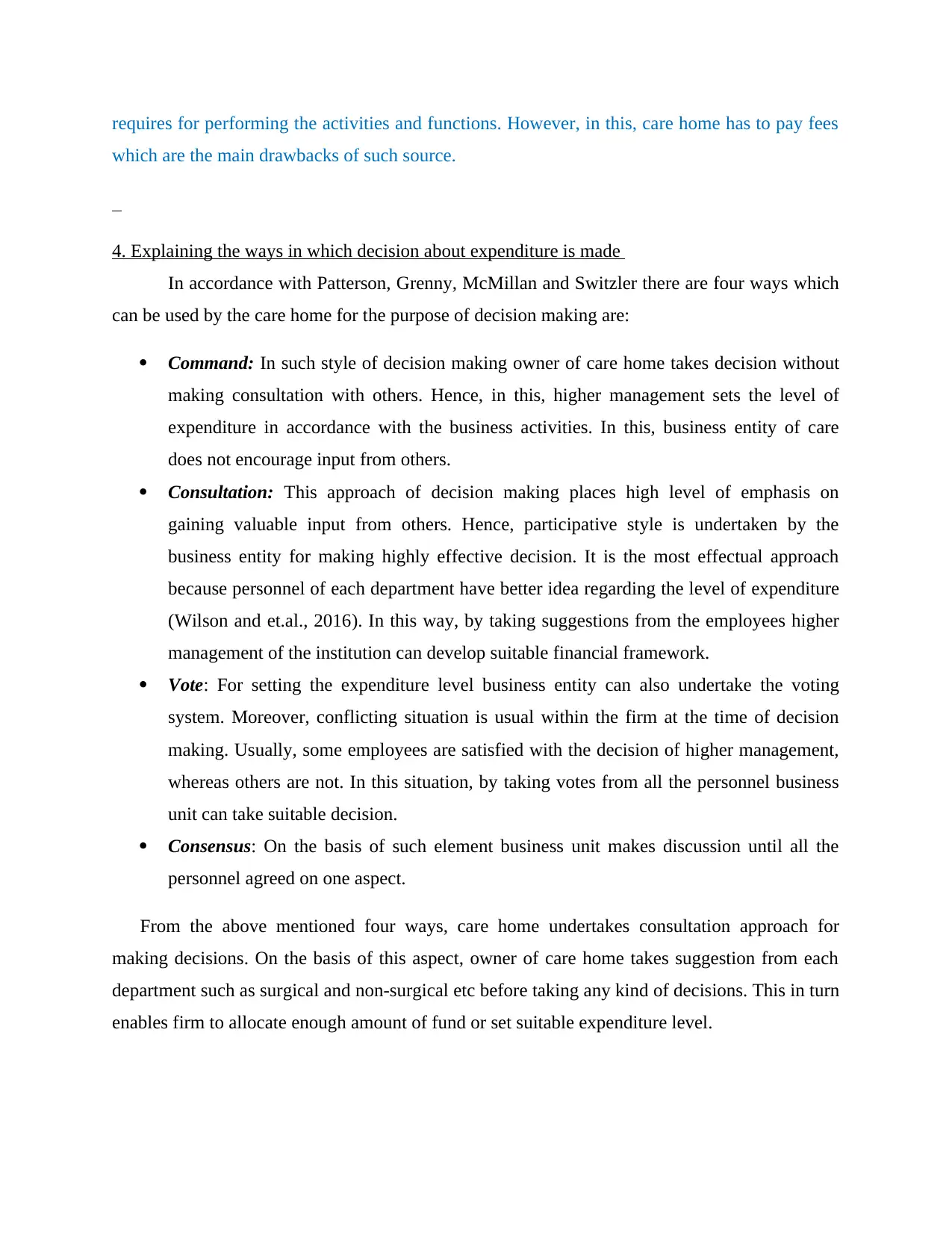
requires for performing the activities and functions. However, in this, care home has to pay fees
which are the main drawbacks of such source.
4. Explaining the ways in which decision about expenditure is made
In accordance with Patterson, Grenny, McMillan and Switzler there are four ways which
can be used by the care home for the purpose of decision making are:
Command: In such style of decision making owner of care home takes decision without
making consultation with others. Hence, in this, higher management sets the level of
expenditure in accordance with the business activities. In this, business entity of care
does not encourage input from others.
Consultation: This approach of decision making places high level of emphasis on
gaining valuable input from others. Hence, participative style is undertaken by the
business entity for making highly effective decision. It is the most effectual approach
because personnel of each department have better idea regarding the level of expenditure
(Wilson and et.al., 2016). In this way, by taking suggestions from the employees higher
management of the institution can develop suitable financial framework.
Vote: For setting the expenditure level business entity can also undertake the voting
system. Moreover, conflicting situation is usual within the firm at the time of decision
making. Usually, some employees are satisfied with the decision of higher management,
whereas others are not. In this situation, by taking votes from all the personnel business
unit can take suitable decision.
Consensus: On the basis of such element business unit makes discussion until all the
personnel agreed on one aspect.
From the above mentioned four ways, care home undertakes consultation approach for
making decisions. On the basis of this aspect, owner of care home takes suggestion from each
department such as surgical and non-surgical etc before taking any kind of decisions. This in turn
enables firm to allocate enough amount of fund or set suitable expenditure level.
which are the main drawbacks of such source.
4. Explaining the ways in which decision about expenditure is made
In accordance with Patterson, Grenny, McMillan and Switzler there are four ways which
can be used by the care home for the purpose of decision making are:
Command: In such style of decision making owner of care home takes decision without
making consultation with others. Hence, in this, higher management sets the level of
expenditure in accordance with the business activities. In this, business entity of care
does not encourage input from others.
Consultation: This approach of decision making places high level of emphasis on
gaining valuable input from others. Hence, participative style is undertaken by the
business entity for making highly effective decision. It is the most effectual approach
because personnel of each department have better idea regarding the level of expenditure
(Wilson and et.al., 2016). In this way, by taking suggestions from the employees higher
management of the institution can develop suitable financial framework.
Vote: For setting the expenditure level business entity can also undertake the voting
system. Moreover, conflicting situation is usual within the firm at the time of decision
making. Usually, some employees are satisfied with the decision of higher management,
whereas others are not. In this situation, by taking votes from all the personnel business
unit can take suitable decision.
Consensus: On the basis of such element business unit makes discussion until all the
personnel agreed on one aspect.
From the above mentioned four ways, care home undertakes consultation approach for
making decisions. On the basis of this aspect, owner of care home takes suggestion from each
department such as surgical and non-surgical etc before taking any kind of decisions. This in turn
enables firm to allocate enough amount of fund or set suitable expenditure level.
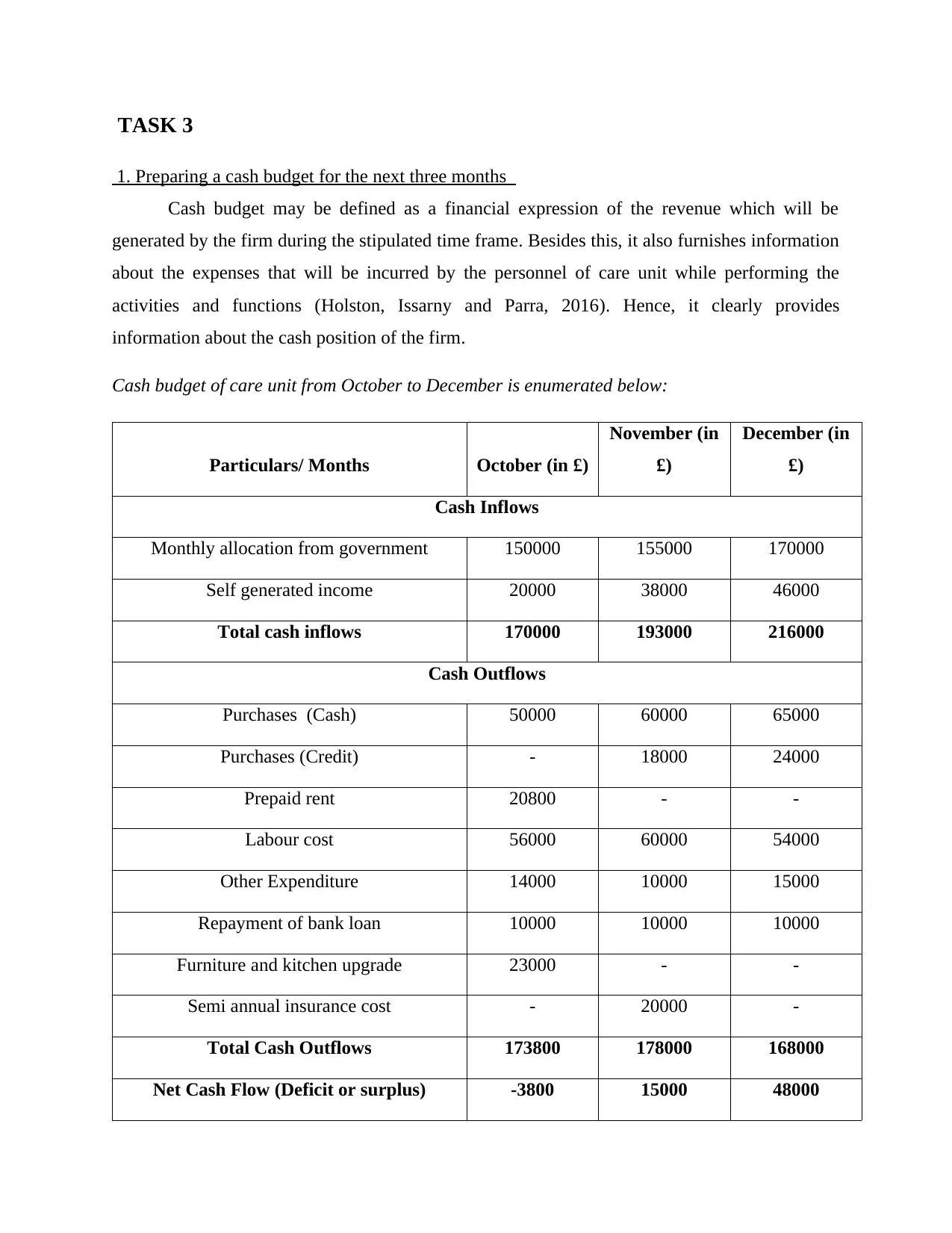
TASK 3
1. Preparing a cash budget for the next three months
Cash budget may be defined as a financial expression of the revenue which will be
generated by the firm during the stipulated time frame. Besides this, it also furnishes information
about the expenses that will be incurred by the personnel of care unit while performing the
activities and functions (Holston, Issarny and Parra, 2016). Hence, it clearly provides
information about the cash position of the firm.
Cash budget of care unit from October to December is enumerated below:
Particulars/ Months October (in £)
November (in
£)
December (in
£)
Cash Inflows
Monthly allocation from government 150000 155000 170000
Self generated income 20000 38000 46000
Total cash inflows 170000 193000 216000
Cash Outflows
Purchases (Cash) 50000 60000 65000
Purchases (Credit) - 18000 24000
Prepaid rent 20800 - -
Labour cost 56000 60000 54000
Other Expenditure 14000 10000 15000
Repayment of bank loan 10000 10000 10000
Furniture and kitchen upgrade 23000 - -
Semi annual insurance cost - 20000 -
Total Cash Outflows 173800 178000 168000
Net Cash Flow (Deficit or surplus) -3800 15000 48000
1. Preparing a cash budget for the next three months
Cash budget may be defined as a financial expression of the revenue which will be
generated by the firm during the stipulated time frame. Besides this, it also furnishes information
about the expenses that will be incurred by the personnel of care unit while performing the
activities and functions (Holston, Issarny and Parra, 2016). Hence, it clearly provides
information about the cash position of the firm.
Cash budget of care unit from October to December is enumerated below:
Particulars/ Months October (in £)
November (in
£)
December (in
£)
Cash Inflows
Monthly allocation from government 150000 155000 170000
Self generated income 20000 38000 46000
Total cash inflows 170000 193000 216000
Cash Outflows
Purchases (Cash) 50000 60000 65000
Purchases (Credit) - 18000 24000
Prepaid rent 20800 - -
Labour cost 56000 60000 54000
Other Expenditure 14000 10000 15000
Repayment of bank loan 10000 10000 10000
Furniture and kitchen upgrade 23000 - -
Semi annual insurance cost - 20000 -
Total Cash Outflows 173800 178000 168000
Net Cash Flow (Deficit or surplus) -3800 15000 48000
⊘ This is a preview!⊘
Do you want full access?
Subscribe today to unlock all pages.

Trusted by 1+ million students worldwide
1 out of 21
Related Documents
Your All-in-One AI-Powered Toolkit for Academic Success.
+13062052269
info@desklib.com
Available 24*7 on WhatsApp / Email
![[object Object]](/_next/static/media/star-bottom.7253800d.svg)
Unlock your academic potential
Copyright © 2020–2025 A2Z Services. All Rights Reserved. Developed and managed by ZUCOL.





